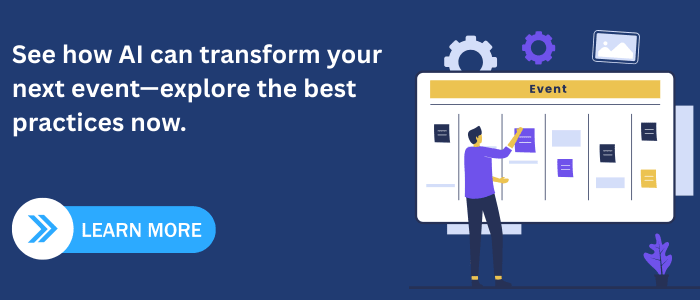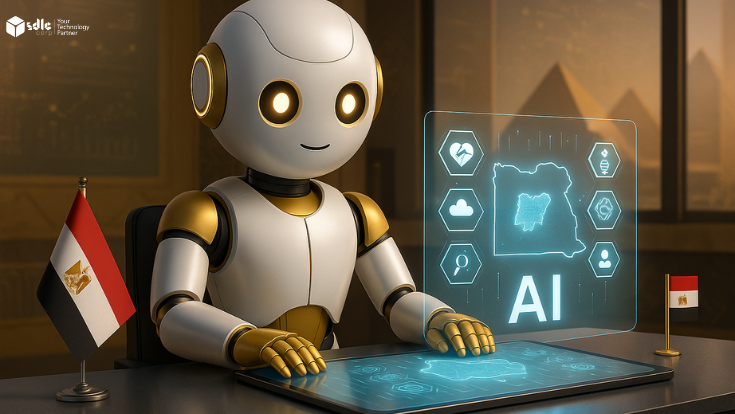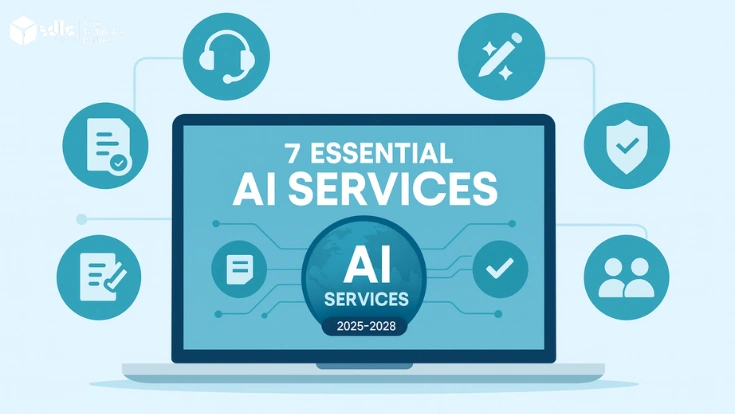Introduction
Event management has always been about balancing multiple moving parts, planning schedules, booking venues, coordinating speakers, and engaging attendees. Traditionally, this work required large teams, long timelines, and careful coordination. Today, Generative AI for event management is reshaping how organizers approach these challenges.
By automating routine tasks, generating event content, and offering real-time support, AI reduces costs while improving the attendee experience. Unlike earlier automation tools, generative AI doesn’t just follow scripts; it creates new content, adapts tone, and delivers insights that feel human.
What Is Generative AI and Why Does It Matter for Events?
Generative AI is a type of artificial intelligence that creates original content, including text, images, video, and even code. Instead of merely processing instructions, it can generate new ideas based on training data. In event management, this capability matters for three reasons. Many businesses now choose to hire generative AI developers to build solutions that make events more engaging, adaptive, and cost-efficient.
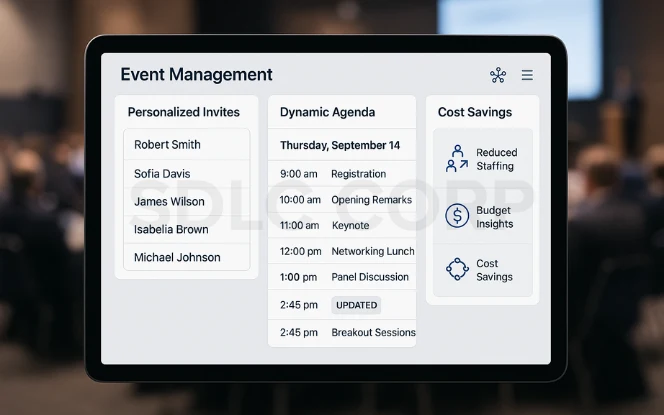
- Personalization at scale – Events thrive on engagement. Generative AI can craft unique invites, agendas, and follow-ups tailored to each attendee.
- Real-time adaptability – During live events, AI can adjust messaging, generate summaries, or update schedules instantly.
- Efficiency and cost savings – Instead of hiring large content and operations teams, AI allows leaner organizations to run events without sacrificing quality.
For organizers, this isn’t just about convenience it’s about delivering more impactful, accessible, and data-informed events.
Key Use Cases of Generative AI in Event Management
Generative AI’s potential goes beyond automating emails or designing banners. With the rise of Generative AI Development Services, below are the most practical applications shaping the industry:
1. Event Content Creation
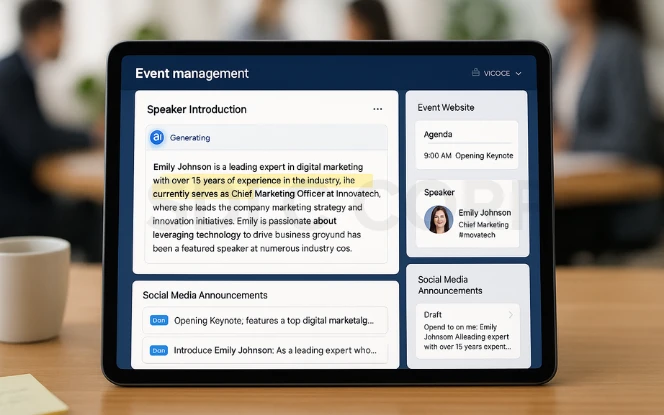
Event managers often spend weeks preparing descriptions, agendas, and bios. AI can generate:
- Compelling session summaries
- Speaker introductions
- Website and app descriptions
- Social media announcements
This not only saves time but ensures consistency across platforms.
2. Marketing and Communication
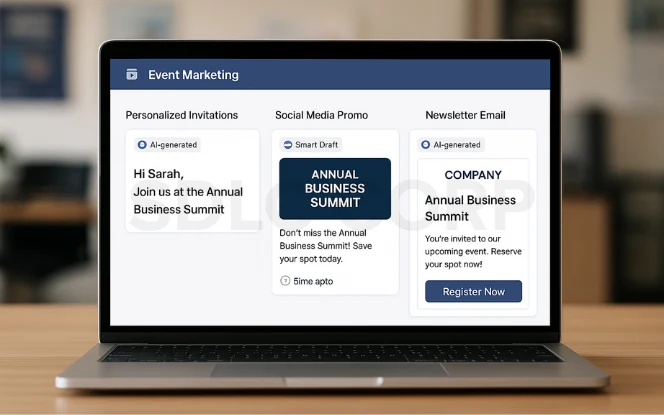
Using AI-driven event planning, organizers can:
- Write personalized invitations for different attendee groups
- Generate promo copy tailored to social media platforms
- Draft newsletters that match the event’s tone
The result is communication that feels human, even when automated.
3. On-Site Assistance
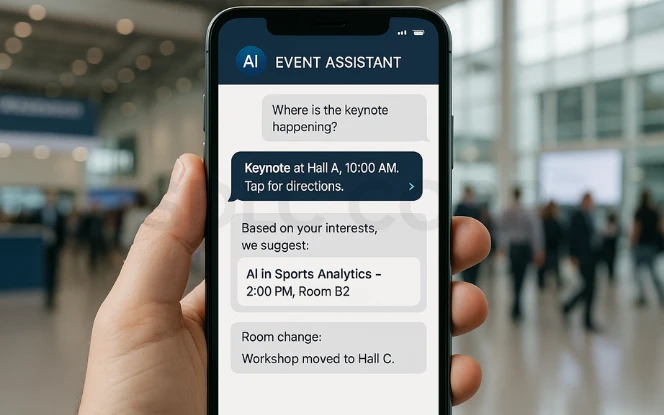
At large conferences, attendees often get lost in the schedule. AI chatbots can:
- Answer real-time questions
- Suggest sessions based on interest
- Provide updates on changes in the agenda
This improves the overall attendee experience without requiring more staff.
4. Attendee Communication and Content Support
Events require clear and timely communication with attendees, speakers, and partners. Generative AI can help draft announcements, session summaries, and post-event reports. In these scenarios, a Generative AI consulting company may assist in identifying suitable use cases and defining content review processes to ensure accuracy and consistency.
5. Post-Event Wrap-Up
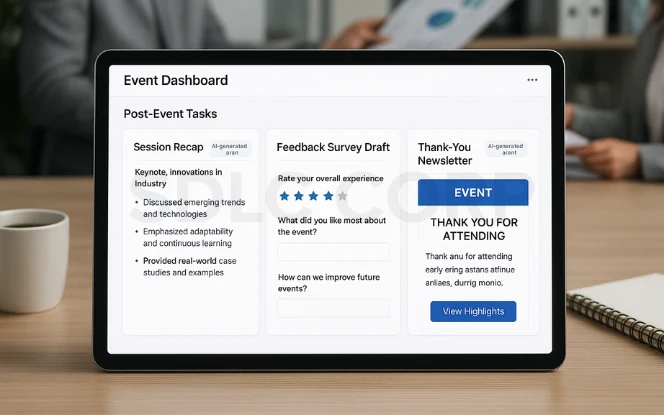
After the event ends, organizers must send reports, thank-you notes, and follow-ups. AI tools can:
- Summarize sessions into concise recaps
- Generate feedback surveys
- Draft post-event newsletters
This helps keep engagement alive even after the event is over.
Real-Time Event Content Generation
One of the strongest advantages of generative AI is its real-time capability. During live sessions, AI can:
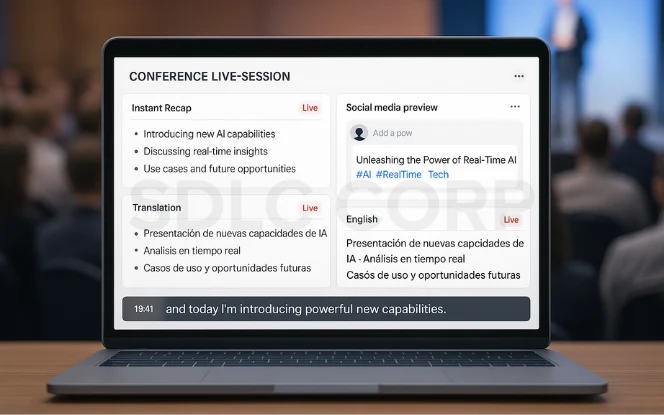
- Create instant recaps of keynote speeches
- Draft LinkedIn or Twitter posts while a session is happening
- Generate translations for multilingual audiences
- Provide live captioning for accessibility
This ensures attendees whether present in person or online, get timely updates without delays.
Imagine a global summit where an AI assistant produces session highlights in multiple languages within minutes. The impact on inclusivity and engagement is profound.
Tools and Platforms Supporting Generative AI in Events
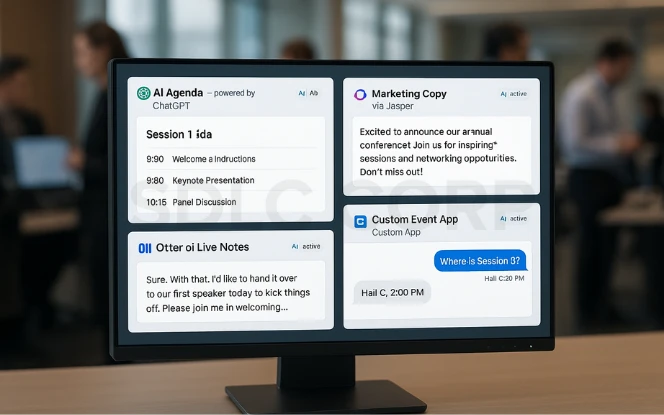
Several platforms are making generative AI accessible to event managers. Examples include:
- ChatGPT / OpenAI models – Generate text for agendas, scripts, or FAQs.
- Jasper – Strong in marketing copy, useful for promotional materials.
- Otter.ai – Provides real-time transcription and meeting notes.
- Custom event apps with AI features – Increasingly offer chatbot and content creation capabilities.
When evaluating tools, organizers should look for features like tone control, multilingual support, integration with event apps, and human-in-the-loop editing.
Best Practices for Implementation
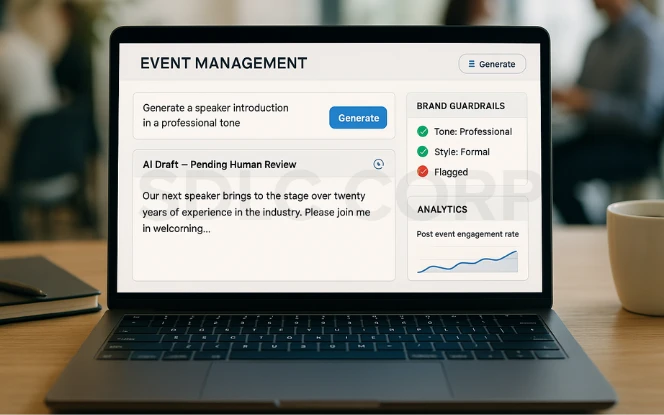
- Start with clear prompts – Vague inputs create vague outputs. Specific instructions lead to relevant content.
- Keep humans in the loop – AI drafts, but humans finalize. This ensures tone, accuracy, and compliance.
- Create brand guardrails – Define tone, language style, and prohibited phrases so AI-generated content aligns with the event’s image.
- Measure and refine – Track attendee engagement to evaluate whether AI-generated content is effective.
Integration with Event Management Platforms:
Generative AI tools are often integrated with registration systems, CRM platforms, and analytics tools. Successful integration depends on stable infrastructure and clear data pipelines.
Event organisers may rely on AI development services to connect generative models with existing systems while maintaining reliability and data accuracy.
Generative AI should be a tool for empowerment, not full replacement.
Risks and Mitigation
- Accuracy issues – AI might generate incorrect or outdated details.
- Bias in content – Outputs can unintentionally reflect biased training data.
- Over-automation – Attendees may notice if communication feels generic.
- Data privacy – Using AI tools that process personal attendee data raises compliance concerns.
Mitigation strategies:
- Always fact-check AI outputs.
- Ensure human review before publishing.
- Use secure, enterprise-grade AI platforms.
- Train AI tools with custom datasets relevant to your event.
By adopting responsible practices, organizers can leverage benefits while reducing downsides.
The Future of Generative AI in Event Management
The event industry is at an inflection point. Future applications may include:
- Predictive event planning – AI could forecast attendee preferences, recommend venues, and optimize budgets.
- Immersive virtual events – Generative AI could build 3D environments, personalized avatars, and live content.
- Advanced personalization – Attendees could receive unique schedules, live recommendations, and AI-generated networking opportunities.
- Voice and video generation – AI may generate speaker introductions in multiple languages, or even create short highlight videos.
For organizations like SDLC CORP, staying ahead means experimenting with these tools now, ensuring that when adoption becomes widespread, teams are already proficient.
Why Neutrality and Balance Matter
When writing about generative AI event automation, it’s easy to fall into hype or fear. However, the reality is more nuanced. Generative AI is not replacing event managers—it’s empowering them. Human expertise, creativity, and emotional intelligence remain central.
At SDLC Corp, neutrality means presenting facts, benefits, and risks without exaggeration. Clients need informed perspectives that help them make clear decisions, not marketing fluff.
Ongoing Development and System Support
Event workflows evolve based on event scale, audience type, and technology changes. Generative AI systems may require updates to reflect these shifts. Some organisations choose to hire generative AI developers to maintain models, update integrations, and ensure systems continue to support operational needs.
Conclusion
Generative AI is no longer a futuristic concept—it’s actively reshaping how events are planned, promoted, and executed. From drafting content and managing real-time updates to post-event reporting, AI enhances efficiency while improving attendee engagement.
However, success requires balance: human oversight, quality control, and ethical safeguards. Organizations that adopt generative AI thoughtfully will enjoy faster workflows, reduced costs, and stronger audience connections.
For event managers, the message is simple: embrace AI as a partner, not a replacement. With the right tools and practices, Generative AI for Event Management will unlock a new era of efficiency, creativity, and scale.
FAQ's
What is generative AI in event management?
Generative AI is technology that creates new content like text, images, or summaries. In events, it helps with invites, agendas, recaps, and more.
How can generative AI improve attendee experience?
It delivers personalization at scale, offers real-time updates, suggests sessions, and provides accessibility features like live captions.
Can AI replace human event planners?
No. AI is a support tool. Humans remain essential for finalizing content, maintaining brand voice, and ensuring overall event quality.
What are examples of AI tools used in events?
Popular tools include ChatGPT for content generation, Jasper for marketing copy, Otter.ai for transcriptions, and custom event apps with AI chatbots.
Is generative AI cost-effective for events?
Yes. It reduces the need for large content and operations teams, allowing leaner organizations to manage events without losing quality.
What are best practices for using generative AI in events?
Use clear prompts, keep humans in the loop, set brand guidelines, and track engagement to measure effectiveness.

